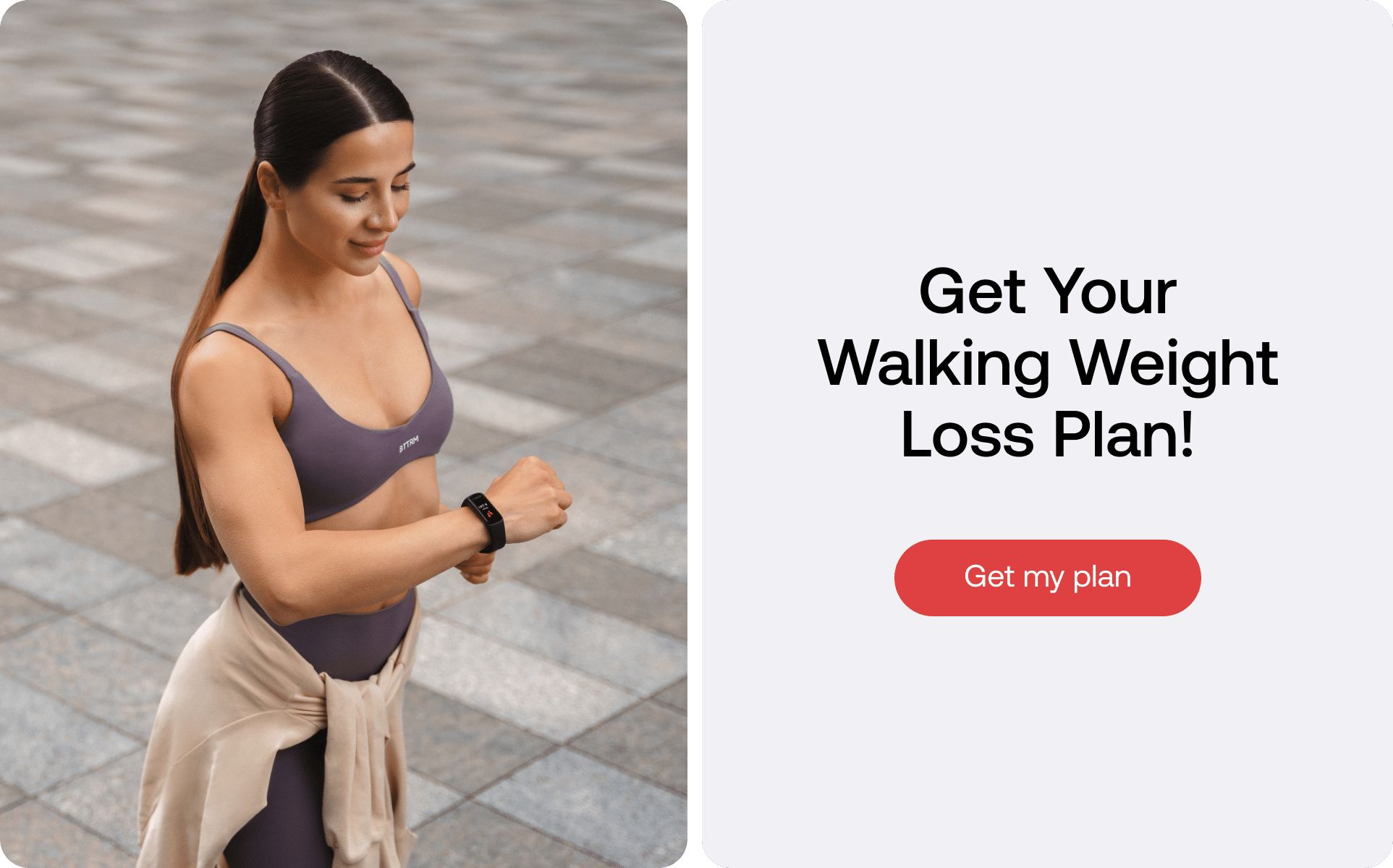You have surely opened this article, because like other people you’re aiming to lose weight and you’re mulling over one crucial question – “Is walking or running better for weight loss?”.
You like walking and probably walk daily thinking that it’s high time you picked up the pace. Or maybe you follow a running routine, but are feeling like you want to slow down a bit since it’s hard to integrate this activity into your weekly training.
The truth is, walking and running are both celebrated for their benefits for overall weight and well-being. No matter how you move your body, every movement counts as an additional step in your body transformation.
That said, sometimes you desire faster results, especially when it comes to shedding pounds. The least you want to do is to buy a gym membership and lift heavy loads under a trainer’s supervision.
In this case, walking and running are the ideal win-to-win strategies for losing weight gradually. But before choosing the right way for yourself, take a look at the versatile factors that are outliined in this article.
Spoiler: both running and walking are good for your health but one of them might be a tad better option.
Is it better to walk or run to lose belly fat?
When it comes to walking or running to burn belly fat, there are different opinions based on the studies.
One study showed that regular aerobic exercises, such as walking, reduced belly fat and helped people manage obesity (2).
And yet, there is another study addressing the more effective impact of running on belly fat. The participants of the study were 27 middle-aged females with obesity. The results indicated that those who participated in high-intensity exercise training for 16 weeks lost significantly more belly fat than those who did low-intensity exercise or no exercise during the same time length (3).
More research is needed to compare the effects of walking and running on belly fat reduction. Interestingly, another review in 2018 found that low-intensity exercise was more effective in reducing abdominal fat, while high-intensity training is more effective for decreasing overall body fat (4).
And now you’re a bit perplexed thinking which way is better for fat loss? Basically, both walking and running are great activities which might help you meet your belly fat-loss goals. If you’re aiming to lose belly fat, an important thing to do is speak with your doctor who can help you determine the best exercise program and diet for your needs.
Want to build an attention-grabbing bubble butt, blast away fat that’s stored in all the wrong places, spring-clean your diet, turn back the clock on your skin, skyrocket your self-confidence and shatter your insecurities? Check out the BetterMe app and set this plan in motion!
Is walking or running better for fat loss?
When referring to walking or workout better for weight loss or running, every trainer will tell you one thing: every movement is effective.
You already know that cutting back weight requires calorie deficiency which means you need to burn more calories than you consume. If we look at calorie burn, then there is a clear winner – running.
Running burns more calories per minute than walking. For instance, a person who weighs 160 pounds, walking at a pace of 3.5 miles per hour for 30 minutes burns about 156 calories. Running at 6 mph for the same time burns about 356 calories (9).
The study in 2013 compared weight changes of 50,000 walkers and runners and found that walking led to weight loss in most individuals, especially female walkers. However, they also concluded that running was more effective at dropping pounds for men overall, and for women starting with the most pounds (6).
Does that mean walking is less effective? When you’re striving for quick results, running is a clear choice. But that doesn’t mean you won’t attain the desirable weight loss results if you pick walking. In addition, running may not be the best choice for everyone since:
- Not everyone can do it regularly
- It puts more pressure on your joints. According to a 2020 review, running is more demanding on your joints and muscles, which might not be a good option for people especially those with preexisting health conditions or beginners (5).
- It may lead to injuries if you fail the proper running technique. Common running injuries include Runner’s knee, Achilles tendonitis, shin splints, stress fractures, plantar fasciitis, and iliotibial band syndrome (9).
Instead of focusing on the intensity, think about which of these activities you can do consistently. Despite being low-impact, walking can give you similar weight-loss results if you walk longer distances.
It is much easier to incorporate walking into your daily routine as walking is a gentler, more accessible option, allowing for longer exercise sessions and leading to more calories burned. Hence, the most effective weight-loss exercise is the one you can perform consistently.
Read more: The 28-Day Indoor Walking Weight Loss Challenge Explained
How much should I walk or run a day to lose weight?
If you want to lose weight, shedding one pound a week may be a sensible target for you. Let’s start with walking. Aiming to walk for 30-90 minutes several days each week will help you to lose weight.
Brisk walking for 30 minutes typically results in a distance of 1.5-2 miles or 3,000-4,500 steps. Make sure the total walking time per week is at least 150 minutes (1).
Try not to skip more than one day as consistency boosts your calorie expenditure, improves metabolism, and builds healthy new habits. On non-walking days, perform strength training exercises.
Concentrate less on the steps and more on the powerful tactics which include:
- walking outdoors
- picking up the pace
- walking uphill
- carrying weight while walking (7). I would suggest putting some kind of disclaimer here. Adding weight to your walk can cause bad form (change gait) leading to injury. I believe the article that was used here for reference also talked about this. Please add something like “ease into carrying weight and remember the importance of proper form when adding weight to your walk” .
Those who can’t afford to walk outdoors consistently can reap the benefits from the Indoor Walking Routine – another efficient way to shed calories in your house, especially when you work from home.
Running is a more vigorous form of exercise which makes it not suitable for daily workouts. Aim for two to three runs a week. Start by doing a 20-minute run.
You can also alternate between high- and low-intensity workouts. As you progress and feel more powerful, you can extend the running time to 30-60 minutes.
After strenuous activity, you need to give your body a chance to recover and rebuild itself. That’s why you need to take daily breaks between your runs.
Dropping pounds by the dozens without putting yourself through the wringer is everyone’s weight loss pipe dream. But what if we told you that the BetterMe app can make that happen? Keep yourself in prime shape with our fat-blasting workouts, delicious budget-sparing recipes, and body-transforming challenges with our app!
Is it better to walk fast or jog slow?
Both walking fast and jogging are good for you. You should pick according to your overall goals.
Those who seek to lose weight may take more advantage of slow jogging. Researchers in the study in 2014 found that regular runners — including slow joggers — were 30 percent fitter compared to walkers and sedentary people. They also had a 30 percent lower risk of dying over the next 15 years (8).
Does this mean you should get into a jogging routine and avoid walking? No, as walking offers an array of health benefits on its own:
- reduced risk of heart disease and stroke
- increased muscle strength and endurance
- management of conditions such as high blood pressure, diabetes, high cholesterol, joint and muscular pain or stiffness
- stronger bones
- improved balance and coordination
- reduced body fat (11).
A combination of walking and jogging is another good strategy for losing weight and ramping up your overall health. You could jog one day and walk the next one, alternating between them daily. You could use a special Walk To Run Program if you’re interested in alternating between walking and running.
Why is walking better than running?
Walking may be better than running for its accessibility and effectiveness on a long-term basis. Despite being more efficient for quicker weight loss, running may not be feasible for everyone in the long term.
According to a 2023 small study, the high impact of running over time can lead to fatigue or even injuries, especially for older people. Walking, by contrast, is a lower-impact exercise that many people can comfortably incorporate into their daily routines (10).
There are other vital factors contributing to starting your walking routine:
- Walking requires no special experience beforehand. All you should do is put on your comfy shoes and clothing and start moving.
- You can walk at any time of the day on your own or invite a friend for a shared long stroll.
- You can change the pace and the incline which will help you shed more calories. Plus, it jazzes up your mundane walking routine.
- Walking can be done everywhere: in the park, forest, in the neighborhood, in water, or mountains, while running requires specific structures to reduce the risk of injuries. Starting with an Indoor Walking Workout could benefit both beginners and those who can’t go outside as much as they desire.
Overall, walking is often an underestimated exercise which people take for granted, as we do it daily. However, some people may not walk enough during the day without adding any strength training as compensation.
A sedentary life may be harmful for you leading to possible weight gain and other health conditions. That’s why implementing consistent walking into your life is a robust step in promoting your health.
FAQs
Will running 5k 3 times a week lose weight?
Yes, running for 5k three times a week can help you lose weight. Yet, you should do it consistently and gradually enhance the running intervals. Aside from running, try to add other forms of strength training workouts, eat food that contains enough protein and fiber, and sleep well.
Is running 3 km a day enough to lose weight?
Yes, running 3 km per day is enough to burn fat. However, you should take daily breaks between your runs to promote your muscle recovery. Running daily may negatively impact your joint health and increase the risk of injuries.
What burns fat the fastest?
The most effective ways to burn fat fast include high-interval intensity training, intermittent fasting (consult a doctor before trying it out), eating protein with meals, cutting back on sugar and refined carbs, eating enough fiber, balancing gut bacteria (consume more veggies and fermented foods), getting enough sleep, and lastly managing stress levels.
The Bottom Line
Is walking or running better for weight loss? In this article you have unlocked the difference between walking and running and its impact on weight loss.
Let’s sum it up.
Walking may be more beneficial for abdominal fat loss than running while running is better for faster whole-body weight loss. Running helps you burn more calories but this activity isn’t feasible for everyone, particularly older people, beginners, and those who face certain health conditions.
To lose weight, you should walk at least 20 minutes daily and extend the intervals through time. If you choose running as a main weight loss strategy then expect to run at least 20 minutes extending it to 30-60. Note that taking daily breaks from running is obligatory for muscle recovery and reduced risk of injuries.
Comparing walking and slow jogging for weight loss, the latter is more effective. Still, brisk walking or casual walking may be better than running as they don’t require any past sports experience and can be performed anywhere.
If you’re still pondering on the best way to lose weight and not ready to incorporate runs into your routine now, pick walking as the great alternative. This activity is better than nothing and it offers a range of benefits for your mental and physical health.
DISCLAIMER:
This article is intended for general informational purposes only and does not serve to address individual circumstances. It is not a substitute for professional advice or help and should not be relied on for making any kind of decision-making. Any action taken as a direct or indirect result of the information in this article is entirely at your own risk and is your sole responsibility.
BetterMe, its content staff, and its medical advisors accept no responsibility for inaccuracies, errors, misstatements, inconsistencies, or omissions and specifically disclaim any liability, loss or risk, personal, professional or otherwise, which may be incurred as a consequence, directly or indirectly, of the use and/or application of any content.
You should always seek the advice of your physician or other qualified health provider with any questions you may have regarding a medical condition or your specific situation. Never disregard professional medical advice or delay seeking it because of BetterMe content. If you suspect or think you may have a medical emergency, call your doctor.
SOURCES:
- [Aerobic physical activity and dietary advice advocated in obesity and overweight] (2015, ncbi.nlm.nih.gov)
- A systematic review and meta-analysis of the effect of aerobic vs. resistance exercise training on visceral fat (2011, ncbi.nlm.nih.gov )
- Effect of exercise training intensity on abdominal visceral fat and body composition (2008, ncbi.nlm.nih.gov)
- Effect of High-Intensity Interval Training on Total, Abdominal and Visceral Fat Mass: A Meta-Analysis (2017, springer.com)
- Factors Affecting Training and Physical Performance in Recreational Endurance Runners (2020, ncbi.nlm.nih.gov)
- Greater Weight Loss from Running than Walking during a 6.2-yr Prospective Follow-up (2013, lww.com)
- How Many Steps Do You Really Need? That’s the Wrong Question (2024, nytimes.com)
- Leisure-time running reduces all-cause and cardiovascular mortality risk (2014, ncbi.nlm.nih.gov)
- The Difference Between Walking and Running (2021, webmd.com)
- The effect of fatigue on running mechanics in older and younger runners (2022, ncbi.nlm.nih.gov)
- Walking for good health (betterhealth.vic.gov.au)










